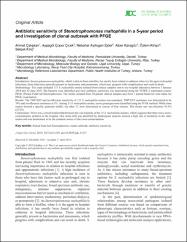Antibiotic sensitivity of Stenotrophomonas maltophilia in a 5-year period and investigation of clonal outbreak with PFGE

View/
Access
info:eu-repo/semantics/openAccessDate
2019Author
Çalışkan, AhmetÇiçek, Ayşegül Çopur
Ejder, Nebahat Aydoğan
Karagöz, Alper
Kirişçi, Özlem
Kılıç, Selçuk
Metadata
Show full item recordCitation
Çalışkan, A., Çopur Çicek, A., Aydogan Ejder, N., Karagöz, A., Kirişci, Ö., & Kılıç, S. (2019). Antibiotic sensitivity of Stenotrophomonas maltophilia in a 5-year period and investigation of clonal outbreak with PFGE. Journal of infection in developing countries, 13(7), 634–639. https://doi.org/10.3855/jidc.11171Abstract
Introduction: Stenotrophomonas maltophilia, which is able to form a biofilm, has mostly been related to catheters when it is the agent in hospital infections; these infections generally present as bacteremia and pneumonia, which may progress with complications and result in death. Methodology: the study included 153 S. maltophilia strains isolated from clinical samples sent to our hospital laboratory between 1 January 2014 and 30 June 2018. the bacteria were identified and their antibiotic sensitivity was determined using the VITEK-2 automated system. PFGE (Pulsed Field Gel Electrophoresis): the strains isolated from 34 patient clinical samples and from 1 patient bedcover were taken for PFGE examination. Results: the TMP/SXT and levofloxacin sensitivity of 153 S. maltophilia strains was examined. TMP/SXT resistance was determined to be 39% and levofloxacin resistance at 5%. Among 35 S. maltophilia strains, seven genotypes were identified using the PFGE method. While three strains showed a specific genotype profile, the other 32 were determined to consist of four clusters. the cluster rate was therefore 91.4% (32/35). Conclusions: There was a clonal relationship between the vast majority of the 35 S. maltophilia isolates, which suggests that there was a cross-contamination problem in the hospital. One strain (#4) was identified by dendrogram analysis showed a high rate of similarity to the other strains and was determined to be the common source of the cross-contamination.

















